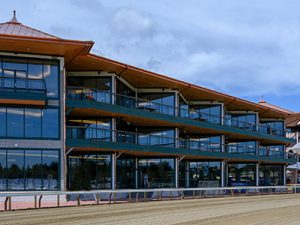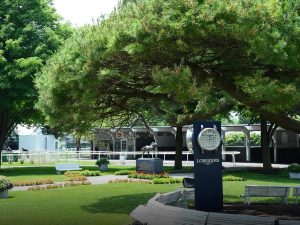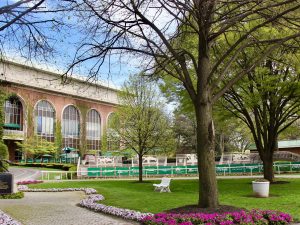By Mike Farrell

1863 Club – Photo Courtesy of NYRA
The Saratoga meet that concluded Monday was a blockbuster. The best in East Coast racing just keeps getting bigger.
Total handle from all sources was a record $705 million for the season, despite losing the second Saturday to a roasting heat wave.
Several tweaks worked. The five-day schedule helped; so did an earlier start to the season.
Total handle soared $46 million, a healthy 7 percent increase over 2018.
“We would not be in this enviable position without the dedication of the owners, the talent of the horsemen and the unmatched enthusiasm of our fans,” said New York Racing Association CEO and President Dave O’Rourke.
The good times, however, don’t last forever. With the Spa season in the rearview mirror, the NYRA circuit motors into Belmont Park on Friday for the start of a new era.

Belmont Park – Photo NYRA
Nothing will ever be the same as Belmont transitions from a majestic racetrack in the best classic tradition to a multipurpose facility.
History suggests that shifts of that nature sometimes bode poorly for racing. The times they are a’ changin’ at Belmont as a sparkling new arena for the NHL’s New York Islanders will be carved from the track’s backyard picnic area.
For those who don’t follow hockey, the Islanders are a once-proud championship franchise that mismanagement turned into a ragtag band of gypsies.
They abandoned their longtime home in the Nassau Coliseum for the Barclays Center in downtown Brooklyn, a facility totally unsuited for hockey. When that experiment failed, the Islanders were a team adrift without a clear roadmap for the future.
And then along came the hockey-at-Belmont concept, presented as a win-win for all concerned. The Islanders future on Long Island would be secured in a complex that includes a hotel, and Belmont Park would get needed facility renovations.
Great for the Islanders. Not so clear how racing benefits in the long run.
Grand old tracks like Belmont and Hollywood Park once commanded huge tracts of land. Over time, the surrounding area starts to fill in and developers hungrily eye the vast chunks of real estate.
We know how it sadly played out in California.
This is not to suggest Belmont faces an imminent threat. But it is something to monitor going forward.

Belmont Park – Photo NYRA
Observers who closely follow racing have long believed three racetracks are an unsustainable operation for NYRA. At one time, Aqueduct appeared destined for development as part of an expansion of adjacent Kennedy Airport.
Oh my, how things have changed. Saratoga remains the jewel of New York racing, its position safe and secure while Aqueduct is humming along thanks to a hugely successful casino.
If a domino ultimately falls, Belmont could be the odd track out.
As for the business immediately at hand, Belmont will host a very short meet, only 23 days, before a Belmont-at-Aqueduct session starts on Oct. 11.
Blame it on preparations for the new arena. First post on weekdays will be 3 p.m. Saturdays and Sundays start at 1 p.m.
The Saturday card on the opening weekend features the conclusion of NYRA’s three race series for 3-year-olds on the turf: the $1 million Jockey Club Derby and the $750,000 Jockey Club Oaks for fillies. You can catch it live on NBC from 4:30-6 p.m. ET.
The other big racing dates at Belmont are Sept. 28 and Oct. 5-6.
On the 28th, the card features the $750,000 Jockey Club Gold Cup (G1), the $300,000 Vosburgh (G1), the $300,000 Beldame (G2) and the $200,000 Pilgrim (G3).
On Oct. 5, it’s the $500,000 Joe Hirsch Turf Classic (G1), the $500,000 Champagne (G1), the $400,000 Hill Prince (G2), the $150,000 Matron (G3), and the $150,000 Belmont Turf Sprint Invitational; the next day, the top races are the $500,000 Flower Bowl (G1), the $400,000 Frizette (G1) and the $150,000 Futurity (G3).
The Jockey Club Gold Cup, Vosburgh, Joe Hirsch, Champagne, Flower Bowl, Frizette and Futurity are all Breeders’ Cup Challenge “Win and You’re In” races.

Mike Farrell has worked in thoroughbred and harness racing for much of his career in journalism. Mike is a turf writer, harness writer, and handicapper, covering and analyzing races at dozens of racetracks around the country. Based on the East Coast, Mike has covered the Triple Crown races and the Breeders’ Cup for a number of publications, including Daily Racing Form, as well as The Associated Press. He spends time at Gulfstream Park taking in the races, and also hits the harness racing circuit in the Northeast region. He’s been a fixture at The Hambletonian and the Haskell Invitational for longer than he’d like to remember.


